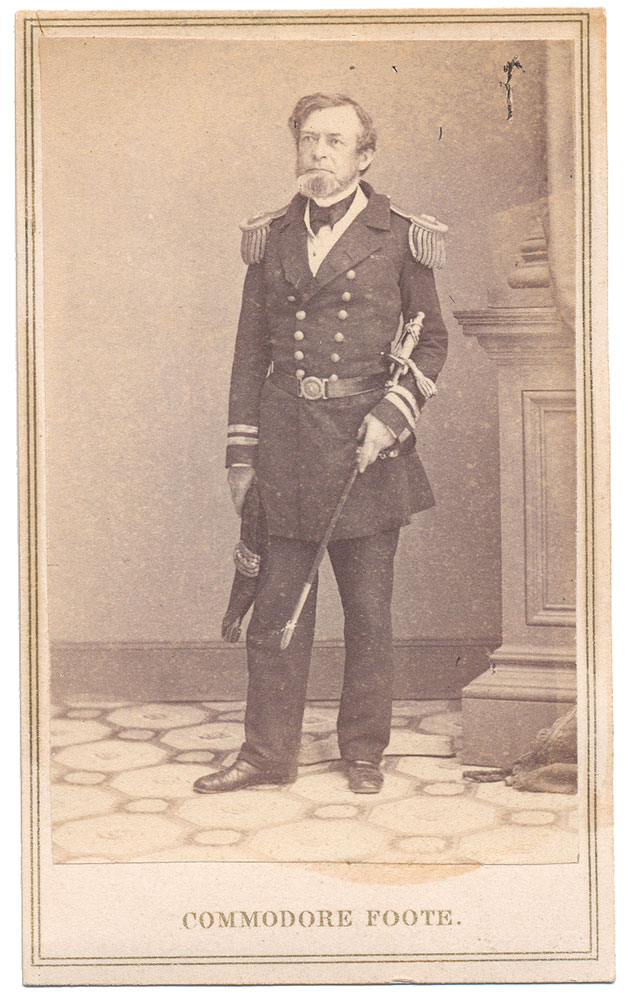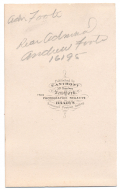site search
online catalog
FULL STANDING VIEW OF UNION COMMODORE ANDREW HULL FOOTE OF CONNECTICUT

$135.00
Quantity Available: 1
Item Code: 160-566
Shipping: Determined by Method & Location of buyer
To Order:
Call 717-334-0347,
Fax 717-334-5016, or E-mail
CDV shows Foote posed by a draped column cradling his sword in his left arm. He wears a dark double-breasted frock coat open at the collar with matching dark trousers. The jacket bears his rank on the cuffs and brush epaulettes on his shoulders. At his waist is his sword belt with tongue and wreath Naval plate and in his right hand he holds hi bi-corn.
Contrast and clarity are very good. Paper and mount are also good. Bottom center of the mount is printed with “COMMODORE FOOTE.”
Reverse has a photographer’s imprint for E. ANTHONY… FROM A BRADY NEGATIVE. There is also some collector information in modern pencil.
Andrew Hull Foote was born at New Haven, Connecticut September 12, 1806. He was the son of Senator Samuel A. Foot (or Foote) and Eudocia Hull. As a child Foote was not known as a good student, but showed a keen interest in one day going to sea. His father compromised and had him entered at the United States Military Academy at West Point. Six months later in 1822, he left West Point and accepted an appointment as a midshipman in the United States Navy.
Between 1822 and 1843, Foote saw service in the Caribbean, Pacific, and Mediterranean, African Coast and at the Philadelphia Navy Yard. He first began as a midshipman on the USS Grampus. In 1830, he was commissioned a lieutenant, and was stationed in the Mediterranean. In 1837, Foote circumnavigated the globe in the USS John Adams. After serving on sea, Foote was put in charge of the Philadelphia Naval Asylum. After serving on land he went back to sea, and organized a Temperance Society aboard the USS Cumberland. This group developed into a movement that resulted in ending the policy of supplying grog to U.S. Naval personnel.
From 1849 to 1851, Foote commanded the USS Perry, cruising the waters off the African coast. He was active in suppressing the slave trade there. This experience persuaded him to support the cause of abolition, and in 1854, he published a 390 page book, “Africa and the American Flag.” He also became a frequent speaker on the Abolitionist circuit.
Foote was promoted to Commander in 1856, and took command of the USS Portsmouth in the East India Squadron. With this command, Foote was assigned the mission of observing British operations against Canton, China, during the Second Opium War. This eventually resulted in his being attacked from Chinese shore batteries. Foote led a landing party that seized the barrier forts along the Pearl River in reprisal for the attack. This led to a short occupation by the U.S. Navy of Chinese territory.
Foote returned to the Continental United States in 1858, and took command of the Brooklyn Navy Yard, in Brooklyn, New York, a post he held until the outbreak of the hostilities of the Civil War.
When the American Civil War began in 1861, Foote was in command of the New York Navy Yard. On June 29, 1861 Foote was promoted to Captain. From 1861 to 1862, he commanded the Mississippi River Squadron with distinction, organizing and leading the gunboat flotilla in many of the early battles of the Western Theater. Even though Foote was an officer in the United State Navy, the Western Flotilla was under the jurisdiction of the Union Army. In early February 1862, now holding the rank of Flag Officer (equivalent to the modern Commodore), he cooperated with General Ulysses S. Grant against Fort Henry on the Tennessee River. Despite heavy damage to one of the gunboats, Foote was able to quickly subdue the fort. Several days later Grant and Foote moved against Fort Donelson on the Cumberland River. Hoping for a repeat of the success at Fort Henry, General Grant urged Foote to attack the fort's river batteries. Fort Donelson's guns, however, were better placed than Fort Henry's were. Three of Foote's gunboats were damaged including the flagship, USS St. Louis. Foote himself received a wound in his foot. For his service at Forts Henry and Donelson, Foote received the Thanks of Congress. After repairing his flotilla, Foote joined with General John Pope in a campaign against Island Number Ten on the Mississippi River. In July 1862 he received a second Thanks of Congress, this time for the battles of Fort Henry, Fort Donelson and Island Number Tenn.
Later in 1862, Foote was promoted to rear admiral. In 1863, on his way to take command of the South Atlantic Blockading Squadron, he suddenly died. His untimely death in New York shocked the nation. He was interred at Grove Street Cemetery in New Haven, Connecticut. [AD] [PH:L]
~~~~~~~~~~~~~~~~~~~~~~~~~~~~~~~~~~~
THIS ITEM, AS WITH ALL OTHER ITEMS AVAILABLE ON OUR WEB SITE,
MAY BE PURCHASED THROUGH OUR LAYAWAY PROGRAM.
CLICK HERE FOR OUR POLICIES AND TERMS.
THANK YOU!
Inquire About FULL STANDING VIEW OF UNION COMMODORE ANDREW HULL FOOTE OF CONNECTICUT
For inquiries, please email us at [email protected]
Most Popular
Historical Firearms Stolen From The National Civil War Museum In Harrisburg, Pa »
Theft From Gravesite Of Gen. John Reynolds »
Selection Of Unframed Prints By Don Troiani »
Fine Condition Brass Infantry Bugle Insignia »
British Imported, Confederate Used Bayonet »
Scarce New Model 1865 Sharps Still In Percussion Near Factory New »
featured item
SUPERB, RARE MOUNTED SERVICE GREATCOAT
This style of cold weather coat is among those which replaced the long-standing model 1819/32 overcoat in favor of the US model 1851 style, the primary overcoat utilized by US army during civil war. While retaining previous patterns sky blue cloth it… (490-7134). Learn More »
site search
Upcoming Events
May 16 - 18: N-SSA Spring Nationals, Fort Shenandoah, Winchester, VA Learn More »




